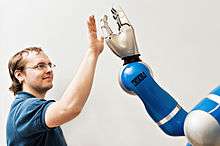Cobot

A cobot[1] or co-robot[2] (from collaborative robot) is a robot intended to physically interact with humans in a shared workspace.[3] This is in contrast with other robots, designed to operate autonomously or with limited guidance,[4] which is what most industrial robots were up until the decade of the 2010s.
Cobots were invented in 1996 by J. Edward Colgate and Michael Peshkin,[5] professors at Northwestern University. A 1997 US patent filing[6] describes cobots as "an apparatus and method for direct physical interaction between a person and a general purpose manipulator controlled by a computer."
Cobots resulted from a 1994 General Motors initiative led by Prasad Akella of the GM Robotics Center and a 1995 General Motors Foundation research grant intended to find a way to make robots or robot-like equipment safe enough to team with people.[7] The first cobots assured human safety by having no internal source of motive power. Instead, motive power was provided by the human worker.[8] The cobot's function was to allow computer control of motion, by redirecting or steering a payload, in a cooperative way with the human worker. Later cobots provided limited amounts of motive power as well.[9]
The General Motors team used the term Intelligent Assist Device (IAD) as an alternative to cobot, especially in the context of industrial material handling and automotive assembly operations.[10] A draft safety standard for Intelligent Assist Devices was published in 2002.[11] An updated safety standard was published in 2016.[12]
Cobotics[13] released several cobot models in 2002.[14] [9]
German based industrial robot pioneer KUKA released in 2004 the first cobot LBR 3. This computer controlled lightweight robot was the result of a long collaboration with the German Aerospace Center institute since 1995.[15] KUKA refined the cobotics technology over the KUKA LBR 4 (2008) to the KUKA LBR iiwa (2013).[16] Universal Robots released its first cobot, the UR5, in 2008.[17] In 2012 the UR10 cobot[18] was released, and later a table top cobot, UR3, in 2015. Rethink Robotics released an industrial cobot, Baxter, in 2012[19] and smaller, faster collaborative robot Sawyer in 2015, designed for high precision tasks.
FANUC - the world's largest producer of industrial robots[20] - released its first collaborative robot in 2015 - the FANUC CR-35iA with a heavy 35kg payload.[21] Since that time FANUC has released a smaller line of collaborative robots including the FANUC CR-4iA, CR-7iA and the CR-7/L long arm version.
Cobots can have many roles — from autonomous robots capable of working together with humans in an office environment that can ask you for help,[22] to industrial robots having their protective guards removed. Collaborative industrial robots are highly complex machines which are able to work hand in hand with human beings. The robots support and relieve the human operator in a conjoint work flow.
During revision and restructuring of the standards relevant to industrial robots, the area of collaborative robots has been established. The revised EN ISO 10218 standard Parts 1[23] and 2[24] and the ISO/TS 15066[25] specification define the safety requirements for collaborative robots. In this context, the collaborative robot also comprises the tools adapted on the robot arm to perform tasks as well as the objects handled by it.
Close cooperation or even direct contact between the operator and the robot inevitably arises the risk of a collision. Consequently, the risk assessment accomplished by the robot manufacturer must also cover the envisioned industrial workplace. EN ISO 10218 Parts 1 and 2 build the basis for the risk assessment, together with the Machinery Directive.
See also
- Air-Cobot, a collaborative mobile robot to inspect aircraft
- Institute for Occupational Safety and Health of the German Social Accident Insurance (IFA): Safe co-operation between human beings and robots (http://www.dguv.de/ifa%3B/fachinfos/kollaborierende-roboter/index-2.jsp)
- Cobot, manufactured by Universal Robots
References
- ↑ "The Words of Tomorrow" Wall Street Journal, January 1, 2000
- ↑ "National Robotics Initiative" National Science Foundation, 2012
- ↑ "Cobot - collaborative robot". peshkin.mech.northwestern.edu.
- ↑ "I, Cobot: Future collaboration of man and machine" The Manufacturer (2015-11-15). Retrieved on 2016-01-19
- ↑ "Mechanical Advantage" Chicago Tribune, Dec. 11, 1996.
- ↑ "Cobots" US Patent 5,952,796
- ↑ "Here Come the Cobots!" Industry Week, Dec. 21, 2004
- ↑ "Cobot architecture" IEEE Transactions on Robotics and Automation, Vol 17. Iss. 4, 2001
- 1 2 "A History of Collaborative Robots: From Intelligent Lift Assists to Cobots" Engineering.com, October 28, 2016
- ↑ "Cobots for the automobile assembly line" International Conference on Robotics and Automation, Detroit, MI, 1999, pp. 728-733
- ↑ ""Draft Standard for Intelligent Assist Devices — Personnel Safety Requirements"" (PDF).
- ↑ "ISO/TS 15066:2016 - Robots and robotic devices -- Collaborative robots". www.iso.org.
- ↑ "Stanley moves into materials handling with Cobotics acquisition" Cranes Today, April 2, 2003
- ↑ ""Intelligent Assist Devices: Revolutionary Technology for Material Handling"" (PDF).
- ↑ ""DLR Light-Weight Robot III"". Archived from the original on 2016-11-14. Retrieved 2016-09-16.
- ↑ "History of the DLR LWR". 2018-03-17.
- ↑ "A Brief History of Collaborative Robots" Engineering.com, May 19, 2016
- ↑ "UR10 Collaborative industrial robotic arm - Payload up to 10 kg". www.universal-robots.com.
- ↑ "Baxter Kinematic Modeling, Validation and Reconfigurable Representation" SAE Technical Paper 2016-01-0334, 2016
- ↑ "FANUC Announces Record-Breaking 400,000 Robots Sold Worldwide". FANUC America Corporation. Retrieved 2017-02-03.
- ↑ "FANUC America Introduces New CR-35iA Collaborative Robot Designed to Work Alongside Humans". FANUC America Corporation. Retrieved 2017-02-03.
- ↑ "CoBot Robots". Carnegie Mellon University. Retrieved 12 March 2013.
- ↑ ISO 10218-1:2011 Robots and robotic devices – Safety requirements for industrial robots – Part 1: Robots. International Organization for Standardization (ISO)
- ↑ ISO 10218-2:2011 Robots and robotic devices – Safety requirements for industrial robots – Part 2: Robot systems and integration. International Organization for Standardization (ISO)
- ↑ ISO/TS 15066:2016 Robots and robotic devices – Collaborative robots. International Organization for Standardization (ISO)